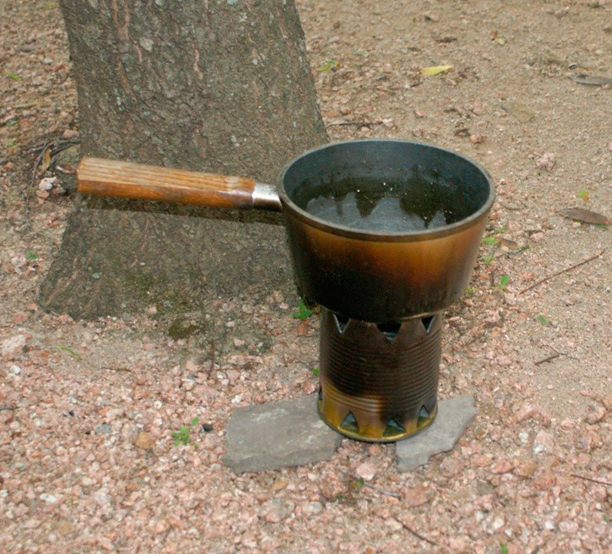We occasionally go to potluck events in our marina where four or five couples are trying to cook their food on a single gas/charcoal grill. There is usually too much food to cook on the grill at one time and we struggle to jockey the food so we all can eat at the same time. Side dishes in pots are usually cooked aboard and brought up the dock to shore to sit and get cold.
No more. We recently discovered the classic hobo stove, a DIY disposable cooking method that is easy, effective, and requires only a tin can and twigs. There are many commercial versions of this stove available in varying sophistications, but why buy something you do not know you need until you need it, something you can make from cans in your trash?
We usually know a day in advance when there is going to be a pot luck in the marina; that’s when we scout our recycle bin for a tin can 28-ounces or larger (28-ounce cans we’ve found to be the smallest size that is effective, it’s difficult to get a hot, long-lasting fire in a smaller can — the bigger the better, and a larger can offers a more stable pot base).
To construct a hobo stove, leave one end, the bottom, in the can and punch a lot of holes around the outside of the rim near the top and bottom with a church key. Fold the pieces out of your way being careful not to cut your fingers. A punch, screwdriver or chisel will make good holes as well, but not with the same ease and precision. An opening can be created to feed the twigs from the side, but this is optional. The bottom of the stove will get very hot so a non-flammable base needs to be found or improvised: rocks, bricks, pan of sand or an upturned clay flower pot will do to protect the surface below the can.
To operate the stove, gather a bunch of small twigs and a starter medium, like newspaper. Put the newspaper inside the can along with a few twigs—you’re making a Barbie-sized campfire. A big fire is not needed, just enough to heat or cook the food. Place your pan on top and add twigs through the holes as needed to sustain the fire for as long as needed to heat your food.
Note that a twig fire will make smoke and soot will accumulate on the bottom of the pot. Coating the bottom of the pot with dishwashing liquid before cooking makes for easier clean-up later. If you’re in a setting where the smoke and ash mess are not welcome, a cleaner alternative is to create an alcohol stove. This is as simple as filling a smaller can (such as a tuna can) with rolled cardboard and stove alcohol and placing it within the larger can, in place of the twig fire. A charcoal fire in the same tuna can is another option. The charcoal alternative may never get hot enough to boil water, but it will stay hot for a long time with little fuss. A third approach is to use charcoal briquettes and stove alcohol together. I’ll place Four or five small briquettes in the tuna can and pour alcohol over them. After the alcohol is soaked up by the briquettes, I add more alcohol to mostly fill the can. Then I place and light. The alcohol fire gets the food really hot quickly and the lower-heat charcoal keeps the food hot for a long time.
This is not elegant, but it’s fun and the food is hot. Bon Appetite!







